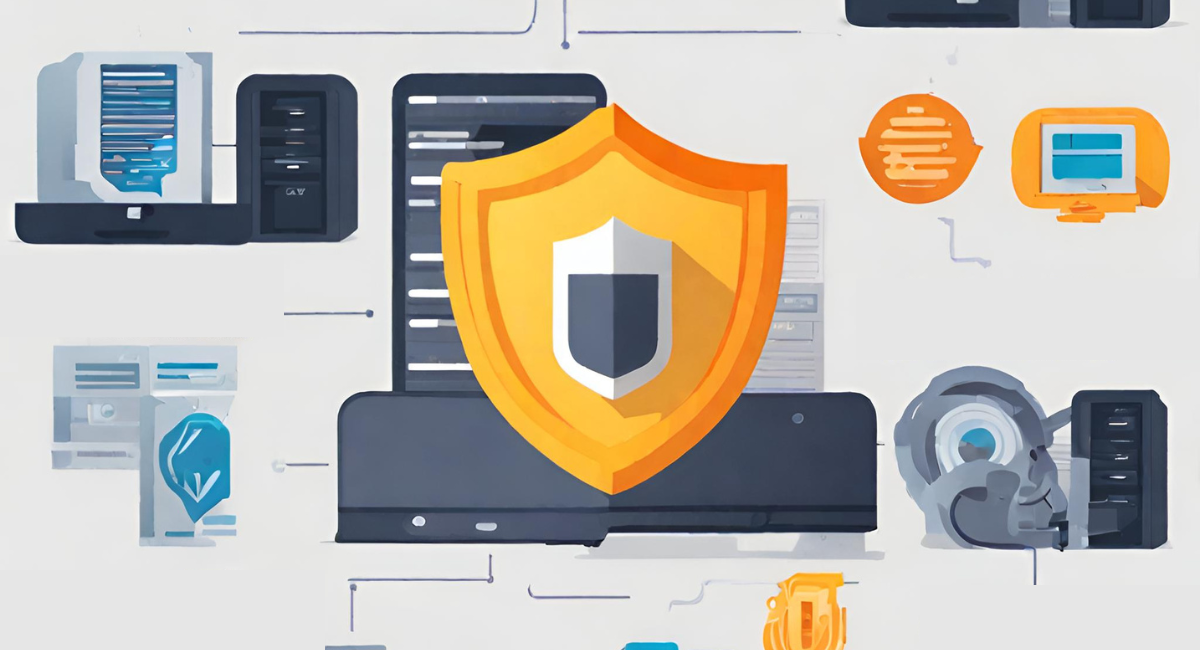The safest way to securely store data involves a combination of encryption, regular data backups, physical data storage security, cloud storage with stringent security measures, and hybrid data storage solutions. Regular audits, updates, and staying informed about emerging technologies are crucial for maintaining and enhancing data security.
In today’s digital age, data security has become a critical fear for individuals and businesses alike. Safely storing data is not just a matter of convenience but is essential for protecting sensitive information from unauthorized access or loss. I will explore the safest way to securely store data, understand the importance of data security, common threats, key principles, different methods, implementing security measures, and the future of secure data storage.
Understanding Data Security

Data security involves implementing measures to protect data from unlicensed access, use, disclosure, disruption, modification, or destruction. The goal is to promise the confidentiality, integrity, and availability of data. In today’s digital age, where data is a valuable asset, data security has become a critical concern for individuals and organizations alike.
When it comes to data security, one of the key aspects is secure data storage. Secure data storage plays a vital role in safeguarding sensitive information. It helps prevent unauthorized access, data breaches, identity theft, and financial losses. By securely storing data, individuals and organizations can protect their reputations and build trust with customers and partners.
The Importance of Secure Data Storage
Secure data storage is not just about keeping data safe from external threats; it also involves ensuring the availability and integrity of data. Availability refers to the skill to access data whenever needed, while integrity ensures that the data remains accurate, complete, and unaltered. Without secure data storage, organizations risk losing valuable data, facing legal consequences, and damaging their relationships with stakeholders.
There are various methods and technologies available for secure data storage. Encryption is one such technique that transforms data into an unreadable form, making it useless to unauthorized individuals. Access controls, such as passwords, biometrics, and multi-factor authentication, can also be implemented to restrict access to sensitive data. Additionally, backup and disaster recovery plans are essential for ensuring data availability in case of unforeseen events like natural disasters or system failures.
Common Threats to Data Security
In today’s interconnected world, several threats can compromise data security. Cybercriminals are always evolving their techniques to exploit vulnerabilities in systems and networks. Malware attacks, such as viruses, ransomware, and spyware, can infect computers and steal sensitive data. Data breaches, where unauthorized individuals gain access to confidential information, are becoming increasingly common and can result in significant financial and reputational damage.
Another significant threat to data security is insider threats. These can be intentional or unintentional, where employees or trusted individuals misuse or mishandle data. Organizations must have strict access controls, monitoring systems, and employee training programs to mitigate the risk of insider threats.
Understanding these threats is crucial for implementing effective data security measures. Organizations need to stay updated with the newest security technologies, regularly assess their systems for exposures, and educate their employees about best practices for data security. By taking a proactive approach to data security, individuals and administrations can minimize the risk of data breaches and protect their valuable information.
Key Principles of Data Storage Security
When it comes to secure data storage, certain key principles should be followed:
Data security is a critical concern for persons and organizations alike. With the growing reliance on digital data, it is essential to implement robust measures to protect sensitive information from unauthorized access, theft, or loss. In this regard, the following key principles play a crucial role in ensuring data storage security:
Data Encryption: A Must-Have
One of the most effective ways to ensure data security is through encryption. By encrypting data, it becomes unreadable and can only be accessed with a unique decryption key. This provides an additional layer of protection, even if the data is compromised.
Encryption algorithms use complex mathematical calculations to transform plain text into ciphertext, rendering it meaningless to anyone without the decryption key. This technique is widely employed in various industries, including finance, healthcare, and government sectors, to safeguard sensitive data such as personal information, financial records, and classified documents.
Modern encryption methods, such as Advanced Encryption Standard (AES) and RSA, offer robust security and are considered industry standards. These algorithms ensure that even if an unlicensed individual gains access to the encrypted data, they would not be able to decipher its contents without the decryption key.
Regular Data Backups and Their Role

Regular data backups are important for data security. By creating backup copies of important data, individuals and organizations can recover from system failures, hardware malfunctions, natural disasters, or ransomware attacks. It is crucial to store backups in secure locations to prevent unauthorized access.
Data loss is due to several reasons including hardware failures, accidental deletion, or malicious activities. Regular backups act as a safety net, allowing users to restore their data to a previous state in the event of data loss or corruption.
Organizations often implement automated backup solutions that create incremental backups at regular intervals. This approach ensures that only the changes made since the last backup are stored, reducing storage requirements and backup time. Additionally, off-site backups, either through physical media or cloud storage, provide an extra layer of protection against physical damage or theft.
Furthermore, it is essential to periodically test the backup restoration process to ensure that the backed-up data is recoverable and intact. Regular testing helps identify any issues or inconsistencies in the backup system, allowing for timely remediation.
By adhering to these key principles of data storage security, individuals and organizations can significantly enhance their ability to protect sensitive information, maintain data integrity, and mitigate the risks associated with data loss or unauthorized access.
Different Methods of Secure Data Storage

When it comes to data storage, security is of utmost importance. Various methods can be employed to ensure the safety of sensitive information. Let’s explore some of these methods in detail.
Physical Data Storage Security
Physical data storage security involves safeguarding data using physical measures. This includes keeping servers and storage devices in secure environments, restricting access to authorized personnel only, using surveillance systems, and implementing physical controls such as locks and biometric authentication.
For example, data centers are designed with multiple layers of security, including controlled access points, video surveillance, and 24/7 monitoring. These measures help prevent unauthorized access and protect against physical threats like theft or damage.
Additionally, organizations may store their data in secure facilities equipped with advanced security features like fire suppression systems and climate control to ensure the integrity and longevity of the stored information.
Cloud Storage: Pros and Cons
Cloud storage has gained popularity due to its convenience, scalability, and cost-effectiveness. It allows users to access their data from anywhere, at any time, using any device with an internet connection. However, it also raises concerns about data security.
While reputable cloud service providers implement robust security measures, individuals and organizations must carefully assess the risks and benefits before storing sensitive data in the cloud. Encryption is often used to protect data during transmission and storage, ensuring that it remains unreadable to unauthorized parties even if it is intercepted.
Furthermore, cloud providers typically have redundant systems and backups to ensure data availability and protection against hardware failures or natural disasters. However, users should be aware that relying solely on a third-party provider for data storage means placing significant trust in their security practices.
Users must understand the terms and conditions of the cloud service provider, including their data retention policies, access controls, and data breach notification procedures. Regularly reviewing and updating security protocols and ensuring strong passwords and multi-factor authentication are also essential to maintaining data security in the cloud.
Hybrid Data Storage Solutions
Hybrid data storage solutions combine on-premises and cloud storage. This approach offers the flexibility to store sensitive data on-site while utilizing the scalability and cost-effectiveness of the cloud for less critical data. It provides a balance between security and convenience.
Organizations can store their most sensitive and confidential data on their servers, where they have complete control over the security measures. This allows them to implement customized security protocols and ensure compliance with industry-specific regulations.
Less critical data, such as archived files or non-sensitive information, can be stored in the cloud. This frees up on-premises storage capacity and reduces costs while benefiting from the cloud’s scalability and accessibility.
Hybrid data storage solutions also offer the advantage of data redundancy. By maintaining copies of data on-premises and in the cloud, organizations can ensure that their data remains accessible even in the event of a localized failure or outage.
However, it is important to note that managing a hybrid storage environment requires careful planning and coordination. Organizations must establish clear data classification policies to determine which data should be stored where and implement robust data transfer and synchronization mechanisms to ensure data integrity and consistency across both storage environments.
In conclusion, secure data storage is critical to protecting sensitive information. Whether through physical security measures, cloud storage, or hybrid solutions, organizations must carefully evaluate their storage needs and implement appropriate security measures to safeguard their data.
Implementing Data Security Measures
Choosing the Right Data Storage Solution
When selecting a data storage solution, it is vital to consider factors such as security features, scalability, accessibility, and compliance requirements. Different types of data may have varying security needs, and it is crucial to choose the right solution that aligns with those requirements.
Regular Audits and Updates for Data Security
Data security is not a one-time task but requires ongoing efforts. Regular audits help identify vulnerabilities and gaps in security measures, allowing for timely updates and improvements. Staying updated with the latest security practices and technologies is vital to staying ahead of evolving threats.
Future of Secure Data Storage
Emerging Technologies in Data Security
The future of secure data storage lies in emerging technologies. Advancements such as blockchain, artificial intelligence, and quantum cryptography show promising potential in enhancing data security. These technologies offer new ways to protect data from cyber threats and mitigate risks.
Staying Ahead of Data Security Threats
As technology continues to evolve, so do data security threats. Being proactive and staying ahead of these threats is crucial for maintaining secure data storage. Organizations and individuals must invest in continuous education, threat intelligence, and the adoption of robust security practices to safeguard their data.
Key Takeaways
- Encryption: One of the most effective ways to defend data is turning it into an unreadable format, which can only be retrieved with a unique decryption key.
- Backup: Regular backups, ideally incremental and off-site, ensure data recovery in case of unexpected data loss or corruption.
- Physical Data Storage: Involves measures like controlled access, video surveillance, and monitoring to prevent unauthorized physical access.
- Cloud Storage: Offers convenience and scalability but requires rigorous scrutiny of provider security measures and practices.
- Hybrid Storage Solutions: Combines the best of both on-premises and cloud storage, offering flexibility, security, and convenience.
FAQs
What is the purpose of secure data storage?
Secure data storage is essential for protecting sensitive information from unauthorized access, ensuring its availability and integrity, and building trust with stakeholders.
Why is encryption important for data security?
Encryption transforms data into an unreadable form, making it inaccessible to unauthorized individuals, even if they get hold of the encrypted data.
How does cloud storage compare to physical data storage in terms of security?
Cloud storage offers scalability, accessibility, and cost-effectiveness, but users place trust in third-party providers’ security practices. Physical storage involves safeguarding data with tangible measures, giving organizations more direct control.
What role do regular backups play in data security?
Regular data backups act as a protection net, allowing data restoration in case of loss, corruption, system failures, or malicious activities.
How can emerging technologies influence the future of secure data storage?
Technologies like blockchain, artificial intelligence, and quantum cryptography offer innovative ways to enhance data security further and protect against evolving cyber threats.
Conclusion
Securely storing data is a paramount concern in our digital era. The combination of understanding threats, leveraging key data storage principles, staying updated with emerging technologies, and implementing rigorous security measures equips individuals and organizations to protect sensitive information effectively. Being proactive and continually evolving with the security landscape is the safest approach to data storage.
